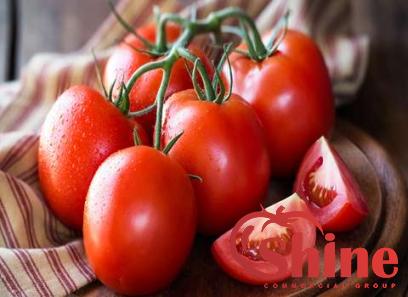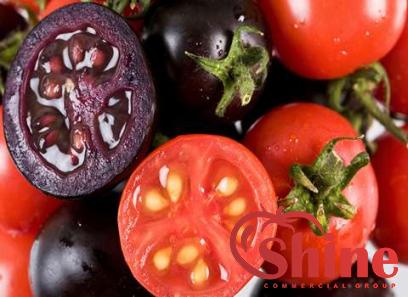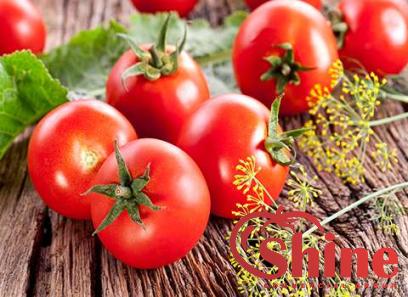Tomato paste is a versatile and popular component in many Italian cuisines and may appear as a substitute recipe for ketchup. It also gives soups, stews, and casseroles a deep and rich umami taste. But what if you run out of tomato paste during cooking? With these easy tomato Paste Substitutes, you can save a last-minute trip to the grocery store.
- Tomato Background Tomato
(Lycopersicon esculentum) is abundantly farmed in our nation, both in the summer and winter seasons. Those produced in the winter, however, are of higher quality because they contain more total solids. They contain a lot of vitamin C. Fresh tomatoes are tasty and refreshing, but they cannot be preserved for a lengthy amount of time. It is believed that a quarter of the output is lost owing to a lack of post-harvest processing procedures in India.
In this case, the manufacturing, storage, and transportation of an intermediate product would assist decrease the significant post-harvest losses and would be very useful to the processing industry’s growth.
However, because of the increased costs involved, advanced technology for bulk storage of tomato pulp has found little use in India. The intermediary items would assist the farmer in increasing crop profit. During the peak harvest season, they are often sold at distressed rates, and a significant portion of the product spoils due to mismanagement. Such losses may be prevented by transforming tomatoes into tasty goods.

Tomato paste ketchup substitute
Tomato paste may be a great substitute for tomato sauce, tomato puree, or ketchup. There’s no need to go to the store or abandon your pizza sauce recipe if you run out of tomato paste.
- Tomato nutritional benefits
Tomato is a warm-season crop that ranks first among crops in terms of nutritional contribution to the diet. Tomatoes are also high in potassium, iron, phosphorus, and B vitamins, as well as a rich source of fiber. Ripe tomatoes are red because they contain lycopene, as well as carotene, anthocyanin, ascorbic acid (vitamin C), vitamin E, phenolics, and flavonoids. Antioxidants have anti-inflammatory, anti-allergic, and anti-thrombotic qualities that help to reduce the risk of cardiovascular disease, cancer, and neurological diseases.
Water makes about 90% of the fresh weight of tomato fruit, and the availability of water determines the fruit’s size to the plant. The fruit is perishable due to the high concentration of water in it. Starch reduces as the tomato fruit matures, whereas carbohydrates such as sucrose and reducing sugars rise.
Sugars are found largely in ripe fruit, whereas starches are present in unripe fruit. Solids account for roughly 5-7 percent of the total fruit weight in a mature tomato. Sugars make up over half of the solids, while acids make up one-eighth. Glucose is the major sugar found in tomatoes. The predominant acid in tomato juice is citric acid, and the pH of the fruit is typically between 4.0 and 4.5. Colored pigments may be found in fruits and vegetables.
The chloroplast contains chlorophyll pigments that are green in hue. Photodegradation, which happens when chlorophyll molecules are bleached by light and oxygen, may also result in the loss of this pigment. This occurs during ripening and senescence. Carotenoids are pigments that vary in hue from yellow to orange-red. Lycopene and beta carotene are two major pigments in tomatoes.
Tomato fruit is eaten in a variety of ways, including raw as a component in a variety of cuisines, sauces, and beverages. It is both a fruit and a vegetable in culinary terms, and it contains carotene, anthocyanin, and other natural antioxidants (George, 2004).
- Antioxidant: Tomatoes are high in vitamins A and C, mostly due to beta-carotene, and these vitamins serve as antioxidants, neutralizing hazardous free radicals in the bloodstream.
- Vitamin A: Because tomatoes contain so much vitamin A, they are also a fantastic diet for improving your eyesight. This also suggests that tomatoes may help your eyes cope with night blindness.
- Calcium: Tomatoes include a significant quantity of vitamin K and calcium, both of which aid to build and maybe heal bones and bone structure in moderate ways.

Tomato paste ketchup
Tomato paste is a fantastic alternative for ketchup when adding it to foods and producing sauces, but cannot be used for dipping since it is too strong. Tomatoes have several health advantages, including improved vision, intestinal health, lower blood pressure, diabetes, skin disorders, and urinary tract infections. Tomatoes are regarded as both a fruit and a vegetable, and they are an important element of cuisine all over the world, particularly in the Mediterranean area.
Tomato eating on a daily basis improves health while also boosting food taste. It has a huge amount of antioxidants that have been shown to fight several types of cancer. It is high in vitamins and minerals and helps to prevent cardiovascular disease. It also promotes eye health and protects against hypertension and urinary tract infections.
- Diabetes: Tomatoes are high in the mineral chromium, which aids diabetics in controlling their blood sugar levels.
- Kidney stones and gallstones: Some research has shown that eating tomatoes without the seeds reduces the incidence of gallstones and kidney stones.
- Heart diseases: Tomatoes can decrease blood pressure and cholesterol levels due to their potassium and vitamin B content. This, in turn, may aid in the prevention of strokes, heart attacks, and other potentially fatal cardiac issues.
- Cancer: Various studies have indicated that the lycopene in tomatoes helps to lower the risk of prostate cancer in males, as well as the risk of stomach cancer and colorectal cancer. Lycopene is regarded as a natural wonder antioxidant that may aid in the prevention of cancer cell development. And, surprisingly, cooked tomatoes have more lycopene than raw tomatoes, so go ahead and enjoy that tomato soup.
- Smoking: No, tomatoes cannot help you quit smoking, but they may help lessen the harm smoking does to your body. Tomatoes include chlorogenic acid and coumaric acid, both of which assist to combat some of the carcinogens caused by cigarette smoke.

ketchup recipe tomato paste
Although we are using canned tomato paste in our ketchup recipe, tomato paste is one of the few ingredients that most chefs prefer to purchase rather than making it. We’ve made it previously, and it wasn’t worth it. The time and expense of tomatoes only made us realize that it’ll be one of the few items we should purchase.
- The significance of tomato processing
Tomato is an important crop that is used to produce fresh vegetables as well as a range of processed goods such as tomato juice, ketchup, sauce, tinned, puree, and paste. Nearly 80% of fresh tomatoes in developed nations are processed. Although tomato output in India is expanding, the expansion of the tomato processing business is gradual, owing to a lack of a consistent supply of high-quality, low-cost raw materials to the processing center.
Tomato sauce and ketchup are popular in India and are being produced on a larger scale, but in limited quantities. Because tomatoes are accessible almost all year, there is potential for large-scale processing operations to be established. The color of a tomato product determines its quality, which is determined by the redness of the tomatoes utilized. In fact, the red pigment (lycopene) may be utilized to determine how much tomato is contained in a product.
Just by:
- plant-ripened evenly red tomatoes may be used to make high-quality tomato products since the yellow and greenish areas not only hide the red hue but also cause browning due to oxidation.
- Avoiding lengthy heating and cooling of the product shortly after preparation; and
- Avoiding the use of iron and copper equipment at any stage of processing. When lycopene (a self-oxidizing isomer of carotene) comes into contact with iron, it becomes brown. With the tannin in the tomatoes and the spices used, iron also produces black compounds. The equipment utilized should be glass-lined or stainless steel.

Make ketchup from tomato paste
Probably the most famous tomato sauce in the world, ketchup is super versatile and tomate paste can be used to make different recipes.
- Considerations for tomato processing
- I Use only plant-ripened red tomatoes as much as feasible. The yellow and green-ish segments conceal the red color of perfectly ripe tomatoes, which turns brown due to oxidation.
- Avoid using iron equipment throughout the procedure. When lycopene comes into touch with iron, it becomes brown. Iron also generates black compounds with the tannin or spices used in tomatoes.
- Avoid extended cooking and immediately chill tomato-based processed items such as ketchup, sauce, chutney, and soups.
- Rinsing tomatoes in water alone is insufficient since mold filaments and other microorganisms located in cracks, wrinkles, folds, and stem cavities are not readily eliminated by gentle washing.
- To prevent fermentation, it is best to pasteurize tomato products after putting them in the bottle.
- One of the major issues with tomato ketchup and sauce-like products is the creation of black necks. It has an impact on the product’s quality. The black neck may be avoided by
- filling hot sauce at a temperature of at least 85°C.
- Leaving as little headroom as possible in bottles (the more the air, than greater is the blackening)
- Reducing iron pollution; iron sources include salt and metal equipment.
- Corn syrup or glucose, which contain sulfur and prevent blackening, as a partial sugar substitute.
- 100 ppm sulfur dioxide or 100 mg ascorbic acid addition
- Keeping bottles horizontal or inverted to allow entrapped air (O2) to spread throughout the bottle, diminishing its concentration at the neck enough to avoid blackening.
- After removing the head, use cloves.

ketchup instead of tomato paste
What ingredients are in home – made ketchup? Ours is just tomato paste, and vinegar, along with several spices. Buy from the store instead of making? they contain high fructose corn syrup, which is why we create our own:
Step 1: Combine tomato paste and vinegar.
Step 2: Mix in the seasonings. That’s it!
- Tomato color characteristics during processing
The plant pigment lycopene is responsible for the appealing red color of tomatoes and tomato products. This pigment’s composition is comparable to that of the well-known yellow plant pigment carotene, which is a precursor to vitamin A. Contrary to common belief, lycopene is not contained in the translucent component of the tomato known as serum, but rather in the insoluble pulp, and is most abundant in fully ripe red tomatoes. When heated, it experiences significant oxidative changes, particularly in the presence of air.
The tannin found in various spices such as clove, cinnamon, and others used in the manufacture of ketchup, sauce, and soup-like processed items also damages the color of the ketchup. As a result, it is vital to limit the assimilation of these tannins using spices. To accomplish this, spice oils, rather than the whole sauce, are often advised. The foregoing features clearly demonstrate the need of selecting completely ripe and red tomatoes for the creation of tomato processed goods in order to get the most color.
Furthermore, green tomatoes tend to become brown when stored. The use of green tomatoes as raw material in the creation of processed goods would naturally contribute to the general darkening of tomato processed development during storage. To avoid this problem, producers in other countries pay close attention to the selection and grading of tomatoes used in tomato product processing. The great quality of the goods would compensate for any loss caused by rejecting unripe tomatoes or clipping off the green areas of partly ripe tomatoes.

However, the bulk of tomato product makers add colors to produce a brilliant red product. To some degree, these hues cover any browning of the newly manufactured product caused by the use of tomatoes that are not completely ripe and red, but this browning obviously shows up with storage.
- The Impact of Processing on Tomato Nutrients
The bioavailability of certain carotenoids, such as beta-carotene, lycopene, and phenolics, increases following tomato processing into value-added products.
The percentage of total trans lycopene – Preserved tomato paste contains 96% of the total lycopene while tomato ketchup contains 77%.
The flavonoid content of processed tomato paste is 65 percent that of fresh tomato.
Because of the release of bound phenolics, the total phenolics concentration in tomato pulp and puree increased during storage.
The loss of ascorbic acid in tomato pulp is 40%, tomato puree is 55%, and tomato paste is 60%.
The scent of processed tomato products differs significantly from that of fresh tomato products. This is related to the loss as well as the formation of volatiles.










Your comment submitted.